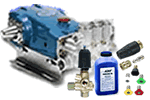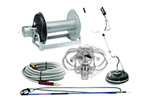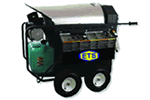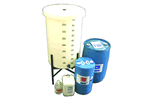Belt vs. Direct Drive Pumps
A “Direct Drive” pump has a hollow shaft, which simply slides onto the drive shaft of a
motor or an engine. The flange on the pump is mounted to the face of the engine. Normal
gasoline engine speed is about 3450 RPM. Since the pump is connected directly to the
engine shaft, the pump rpm is the same as the engine rpm. Electric motors typically will
turn a direct drive pump at 3450 RPM or 1725 RPM. Direct drive pumps allow for a more
compact designed pressure washer.
Benefits of Direct Drive
• Compact Design
• Lower Acquisition Cost
A “Belt Drive” pump has a pulley mounted to its solid shaft and is driven by one or more
belts that are attached to a pulley on the motor or engine. The pulley system allows these
pumps to turn at a much lower RPM than a direct drive pump (typically 900-1400 RPM).
The belt drive pump crankcase has a larger oil capacity. This, combined with the lower
RPM of the belt drive pump, allows the pump to run much cooler than a direct drive pump.
Belts and pulleys also absorb vibration reducing pump fatigue. Because of these factors,
most heavy use pressure washer applications will demand a belt drive pump.
Benefits of Belt Drive
• Vibration Absorption
• Lower RPM
• Lower Operating Temperature
• Longer Life









